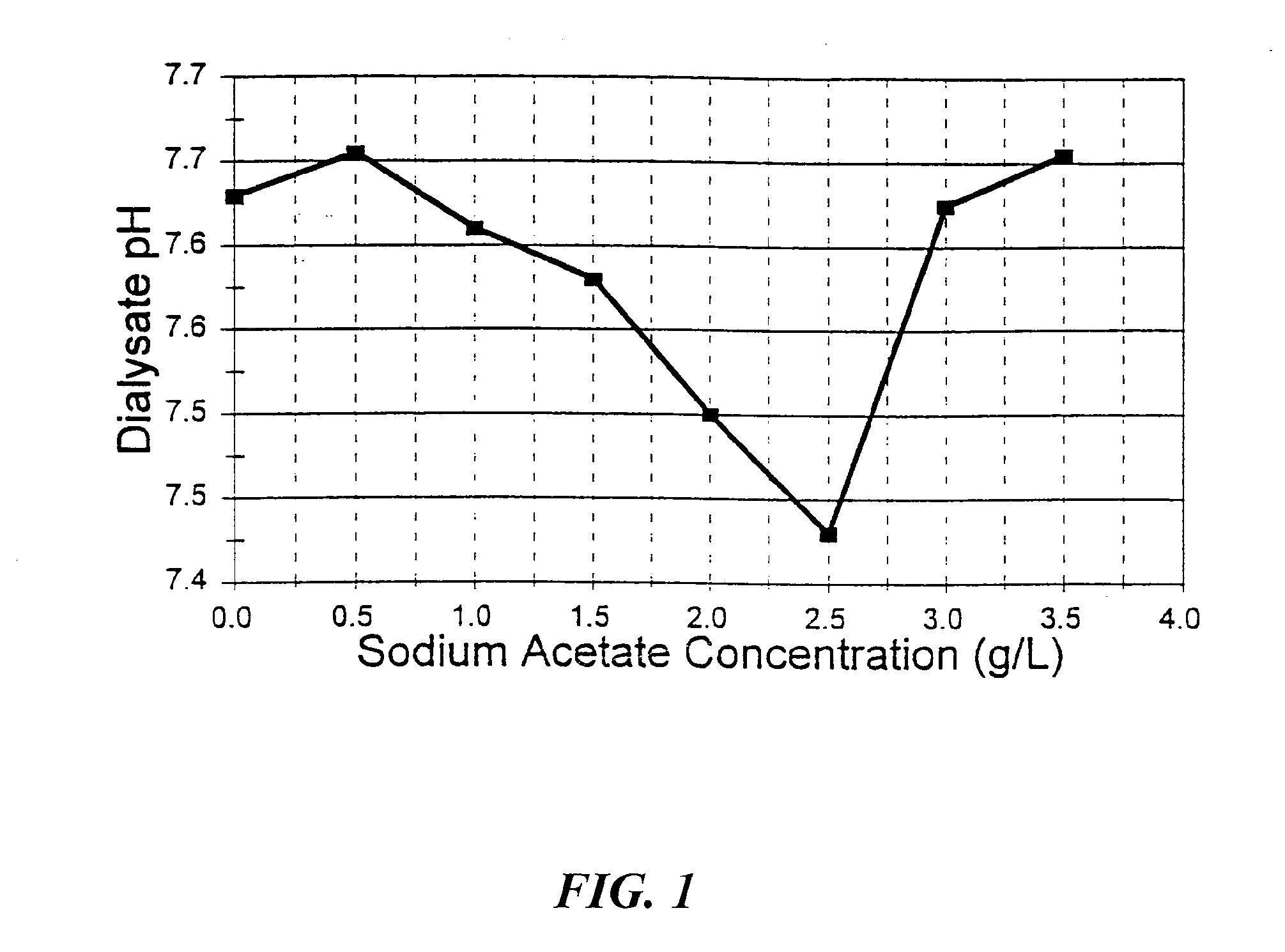Buffered compositions for dialysis
a dialysis and composition technology, applied in the field of therapeutic compositions, can solve the problems of affecting the efficiency of dialysis, affecting the dialysis effect, and many kidney failure patients suffering from chronic acidosis, so as to reduce the concentration of dialysate, reduce the ph of dialysate, and reduce the serum calcium concentration
- Summary
- Abstract
- Description
- Claims
- Application Information
AI Technical Summary
Benefits of technology
Problems solved by technology
Method used
Image
Examples
example 1
Acid Concentrate Formulation
[0118]The following amounts of the indicated USP-grade chemicals were carefully weighed out: 262.0 g sodium chloride (FW 58.45), 9.70 g calcium chloride (dihydrate, FW 147.02), 3.40 g magnesium chloride (hexahydrate, FW 203.3), 90.0 g dextrose (FW 180.16), 7.0 g citric acid (anhydrous, FW 192.12) and 1.75 g of sodium acetate (trihydrate, FW 136.08). The chemicals were placed in a large calibrated beaker and AAMI quality water was added to the 900 ml mark. The beaker was placed on a stirring plate and a stirring bar was used to agitated the chemicals and water. After approximately 10 minutes of stirring, the chemicals had completely dissolved and the solution was ‘crystal clear.’ The stirring bar was removed and the solution was ‘topped off’ with additional AAMI quality water to the 1 liter mark on the beaker. The stirring bar was reintroduced and the solution was stirred for another 3 minutes.
example 2
Hemodialysis
[0119]The beaker of solution as prepared in Example 1 was taken to a Fresenius hemodialysis machine that was ready for use in testing (bypass) mode. In this configuration the machine makes dialysate in the same manner as when a patient is undergoing a dialysis treatment. The treated water supply line was attached to the machine and a container of bicarbonate concentrate was carefully prepared. All solutions were then attached to the machine and it was turned on.
[0120]The machine was allowed to run for 10 minutes at a dialysate flow rate of 800 ml / min. to ensure the prepared solutions had thoroughly filled their appropriate pathways through the machine. Additionally, both the machine's conductivity meter as well as an additional conductivity monitor that had been attached to the dialysate outflow line were monitored, with readings found to stay within the acceptable range (between 1310 and 1330 millisiemens). The pH of the machine-mixed dialysate was monitored by sampling...
example 3
Dialysate Composition
[0122]One liter of dialysate composition, excluding sodium bicarbonate, in mEq / L, contains: sodium, 100.3; chloride, 104.25; calcium, 2.5; potassium, 1.0; magnesium, 0.75; acetate, 0.3; citric acid, 2.4; and, in g / l, dextrose, 2.0. The total chemical composition of this dialysate composition (which did not contain sodium bicarbonate) was (in grams): NaCl (5.822); CaCl2 2H20 (0.139); KCl (0.074); MgCl2 6H20 (0.036); NaC2H3O2 (0.039); C6H8O7 (0.155) and C6H12O6H2O (2).
PUM
| Property | Measurement | Unit |
|---|---|---|
| concentration | aaaaa | aaaaa |
| temperature | aaaaa | aaaaa |
| concentration | aaaaa | aaaaa |
Abstract
Description
Claims
Application Information
 Login to View More
Login to View More - R&D
- Intellectual Property
- Life Sciences
- Materials
- Tech Scout
- Unparalleled Data Quality
- Higher Quality Content
- 60% Fewer Hallucinations
Browse by: Latest US Patents, China's latest patents, Technical Efficacy Thesaurus, Application Domain, Technology Topic, Popular Technical Reports.
© 2025 PatSnap. All rights reserved.Legal|Privacy policy|Modern Slavery Act Transparency Statement|Sitemap|About US| Contact US: help@patsnap.com



